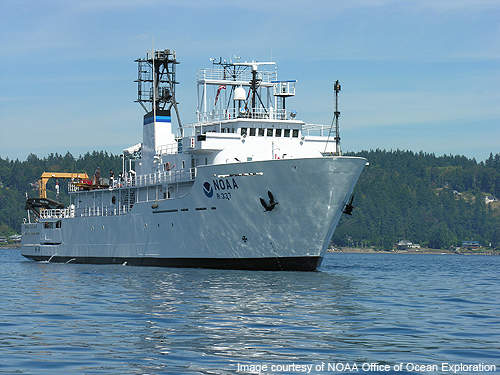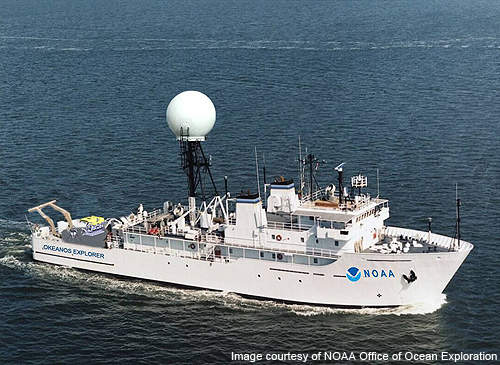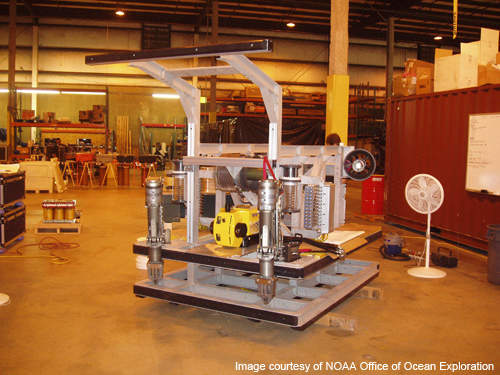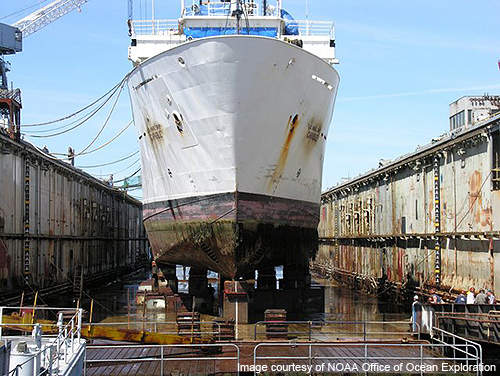Okeanos Explorer, known as “America’s ship for ocean exploration”, is the only American ship dedicated for the sole purpose of ocean exploration and discovery. The vessel was refitted by Todd Pacific Shipyards Corporation and was commissioned in August 2008 by the National Oceanic and Atmospheric Administration (NOAA).
After commissioning in Seattle, both the ship and crew performed field tests off the West Coast to get familiarised with the operations and equipment. The vessel was built to carry out operations around the world. Its purpose is to map sea floors and discover unknown areas of oceans.
Okeanos Explorer history
Okeanos Explorer is a converted US Naval ship called Capable. Built by VT Halter Marine, Capable was launched in October 1988 and entered service in June 1989.
It was transferred to NOAA in September 2004 and converted to conduct deep-ocean exploration. Conversion of the vessel commenced in 2005. It was renamed by a team of five students, who had won NOAA’s nationwide ship-naming contest.
Okeanos Explorer design
The converted Okeanos Explorer has a length overall of 224ft. Its breadth and draft are 43ft and 17ft respectively. Full load displacement of the vessel is 2,312LT and its lightship displacement is 1,616LT.
The endurance of the vessel is 40 days.
Okeanos Explorer construction
During conversion process, a great deal of equipment, and steel was removed from the vessel. New equipment was placed in different places, according to requirements. The vessel was refitted to meet the rules and regulations, prevailing in 2007.
The kitchen was upgraded with new appliances. The dining room was provided with new tables, seats and serving equipment. The heating ventilation and air conditioning (HVAC) system was also upgraded.
Okeanos Explorer propulsion
Okeanos Explorer is fitted with four, 12 cylinder 800hp 600kW, Caterpillar D398B diesel generators. It also has two, 800hp general electric DC drive motors. Propulsion of the vessel is achieved through two, 250hp, hydraulic stern thrusters and one, 500hp, combination azimuthing / tunnel bow thruster. The vessel can cruise at a speed of 10kt.
Navigation and communications
Okeanos Explorer is equipped with Kongsberg K-POS DP-11 Dynamic Positioning System (DPS), which is used to carry over-the-side operations such as precision CTD casts and ROV dives, and ship handling and mapping surveys. For navigation, the vessel is provided with Furuno GP-150 navigation differential global positioning system (DGPS), and mission DGPS.
A location, heading and attitude sensing system provides motion data to DP and multi-beam through Applanix POS/MV 320 v4. The vessel also has two meridian standard gyrocompasses that provide ship direction information. A high accuracy GPS receiver includes C-NAV 2050.
A 3.7m diameter satellite dish, which is fitted atop the mast, allows the mission personnel to send real-time high-definition video feeds, data collected by sensors installed on the ship, and data collected by the hull-mounted multi-beam mapping system.
Equipment
Okeanos Explorer has a dedicated, dual-body remotely operated vehicle (ROV) capable of operating to depths of 6,000m. The ROV is fitted with a high-definition camera to visualise and picture interesting features and habitats. The 3D mapping system of the vessel is a first-of-its-kind multi-beam mapping system. It generates high resolution maps of the sea floor and identifies their unique features.
Deck equipment includes a Dynacon traction winch system, a Markey Desh-5 electric hydrographic winch, a Dynacon A-Frame, a HydraPro Knuckle-boom type crane, a HydraPro HP46 general purpose crane, a J-Frame, two fast rescue boats and two small boat davits.
The traction winch system installed below the deck of the vessel is equipped with a Rochester 2351 electromechanical cable fitted with a model 176 electrical slip ring supplied by Focal Technologies Corporation.
The fast rescue boats, designated as the rescue boats for a man-overboard situation, can also be utilised for crew transfers and scientific purposes.
Each boat can accommodate three crew, five passengers and one stretcher.
Exploration related equipment and instruments on the vessel include a data acquisition system, a Kongsberg Maritime EM302 multi-beam echo sounder, a Kongsberg Maritime EA600 single beam echo sounder, Knudsen 3260 Chirp sub-bottom profiler, radiometers, a Seabird Electronics Model 9/11+ CTD system, a Lockheed Martin-supplied Sippican Mk-21 expendable bathythermograph and a Seabird Electronics SBE-45 thermosalinograph.







